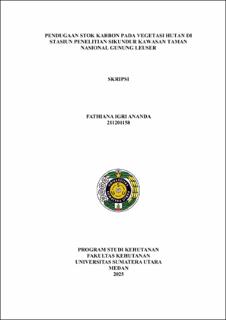Pendugaan Stok Karbon pada Vegetasi Hutan di Stasiun Penelitian Sikundur Kawasan Taman Nasional Gunung Leuser
Carbon Stock Estimation in Forest Vegetation at Sikundur Research Station Mount Leuser National Park Area

Date
2025Author
Ananda, Fathiana Igri
Advisor(s)
Delvian
Siregar, Julius Paolo
Metadata
Show full item recordAbstract
Forest play a crucial role in climate change mitigation due to their ability to act as carbon sinks. This study was conducted to identify vegetation types, assess species diversity, and estimate carbon stock in the secondary forest at the Sikundur Research Station, located within the Gunung Leuser National Park. The research took place from February to March 2025, employing a non-destructive method with an allometric approach. Data were collected from 40 sample plots covering a total area of 1.6 hectares. Parameters observed included plant species, stem diameter, and wood density, which were used to calculate above-ground biomass and its corresponding carbon content. The results revealed 658 individual plants in the pole stratum and 277 individuals in the tree stratum, representing 79 species from 29 plant families. The most frequently encountered species in the pole stratum was Hydnocarpus kunstleri, while Syzygium fastigiatum was the most dominant in the tree stratum. The estimated total biomass across all plots was 429,86 ton/ha, which contained 202,80 ton/ha of carbon. The estimated amount of carbon dioxide (CO₂) absorbed was 744,30 ton/ha, with oxygen (O₂) production reaching 541,49 ton/ha. The Shannon-Wiener diversity index shows that the level of species diversity is relatively high. These findings emphasize the ecological value of secondary forests in carbon sequestration and biodiversity conservation. The data obtained can serve as a scientific basis for formulating sustainable forest management policies and targeted reforestation strategies to strengthen ecosystem resilience and climate mitigation efforts.
Collections
- Undergraduate Theses [2162]
